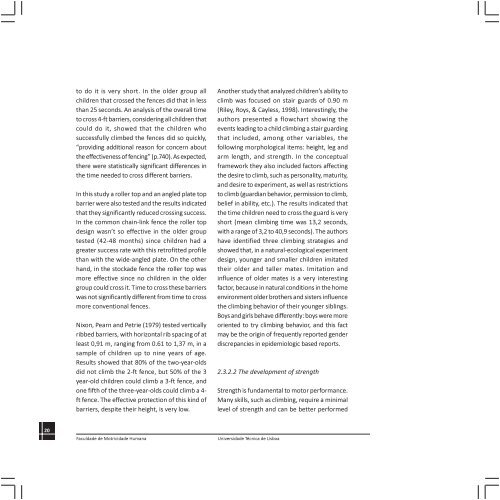Dimensions and Design of swimming pool fences and balcony - ANEC
Dimensions and Design of swimming pool fences and balcony - ANEC
Dimensions and Design of swimming pool fences and balcony - ANEC
You also want an ePaper? Increase the reach of your titles
YUMPU automatically turns print PDFs into web optimized ePapers that Google loves.
to do it is very short. In the older group all<br />
children that crossed the <strong>fences</strong> did that in less<br />
than 25 seconds. An analysis <strong>of</strong> the overall time<br />
to cross 4-ft barriers, considering all children that<br />
could do it, showed that the children who<br />
successfully climbed the <strong>fences</strong> did so quickly,<br />
“providing additional reason for concern about<br />
the effectiveness <strong>of</strong> fencing” (p.740). As expected,<br />
there were statistically significant differences in<br />
the time needed to cross different barriers.<br />
In this study a roller top <strong>and</strong> an angled plate top<br />
barrier were also tested <strong>and</strong> the results indicated<br />
that they significantly reduced crossing success.<br />
In the common chain-link fence the roller top<br />
design wasn’t so effective in the older group<br />
tested (42-48 months) since children had a<br />
greater success rate with this retr<strong>of</strong>itted pr<strong>of</strong>ile<br />
than with the wide-angled plate. On the other<br />
h<strong>and</strong>, in the stockade fence the roller top was<br />
more effective since no children in the older<br />
group could cross it. Time to cross these barriers<br />
was not significantly different from time to cross<br />
more conventional <strong>fences</strong>.<br />
Nixon, Pearn <strong>and</strong> Petrie (1979) tested vertically<br />
ribbed barriers, with horizontal rib spacing <strong>of</strong> at<br />
least 0,91 m, ranging from 0.61 to 1,37 m, in a<br />
sample <strong>of</strong> children up to nine years <strong>of</strong> age.<br />
Results showed that 80% <strong>of</strong> the two-year-olds<br />
did not climb the 2-ft fence, but 50% <strong>of</strong> the 3<br />
year-old children could climb a 3-ft fence, <strong>and</strong><br />
one fifth <strong>of</strong> the three-year-olds could climb a 4-<br />
ft fence. The effective protection <strong>of</strong> this kind <strong>of</strong><br />
barriers, despite their height, is very low.<br />
Another study that analyzed children’s ability to<br />
climb was focused on stair guards <strong>of</strong> 0.90 m<br />
(Riley, Roys, & Cayless, 1998). Interestingly, the<br />
authors presented a flowchart showing the<br />
events leading to a child climbing a stair guarding<br />
that included, among other variables, the<br />
following morphological items: height, leg <strong>and</strong><br />
arm length, <strong>and</strong> strength. In the conceptual<br />
framework they also included factors affecting<br />
the desire to climb, such as personality, maturity,<br />
<strong>and</strong> desire to experiment, as well as restrictions<br />
to climb (guardian behavior, permission to climb,<br />
belief in ability, etc.). The results indicated that<br />
the time children need to cross the guard is very<br />
short (mean climbing time was 13,2 seconds,<br />
with a range <strong>of</strong> 3,2 to 40,9 seconds). The authors<br />
have identified three climbing strategies <strong>and</strong><br />
showed that, in a natural-ecological experiment<br />
design, younger <strong>and</strong> smaller children imitated<br />
their older <strong>and</strong> taller mates. Imitation <strong>and</strong><br />
influence <strong>of</strong> older mates is a very interesting<br />
factor, because in natural conditions in the home<br />
environment older brothers <strong>and</strong> sisters influence<br />
the climbing behavior <strong>of</strong> their younger siblings.<br />
Boys <strong>and</strong> girls behave differently: boys were more<br />
oriented to try climbing behavior, <strong>and</strong> this fact<br />
may be the origin <strong>of</strong> frequently reported gender<br />
discrepancies in epidemiologic based reports.<br />
2.3.2.2 The development <strong>of</strong> strength<br />
Strength is fundamental to motor performance.<br />
Many skills, such as climbing, require a minimal<br />
level <strong>of</strong> strength <strong>and</strong> can be better performed<br />
20<br />
Faculdade de Motricidade Humana<br />
Universidade Técnica de Lisboa
















